Opel Monza
| Opel Monza | |
|---|---|
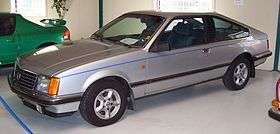 | |
| Overview | |
| Manufacturer | Opel (General Motors) |
| Also called | Vauxhall Royale Coupé |
| Production | 1978–1986 |
| Assembly | Rüsselsheim, Germany |
| Body and chassis | |
| Class | Executive car (E) |
| Body style | 2-door fastback coupé |
| Platform | V platform |
| Related |
Bitter SC Coupé Opel Senator A |
| Dimensions | |
| Wheelbase | 2,670 mm (105.1 in) |
| Length | 4,692 mm (184.7 in) |
| Width | 1,734 mm (68.3 in) |
| Height | 1,380 mm (54.3 in) |
| Curb weight | 1,375 kg (3,031 lb) - 1,420 kg (3,131 lb) |
| Chronology | |
| Predecessor | Opel Commodore Coupé |
The Opel Monza is an executive fastback coupe produced by the German automaker Opel from 1978 to 1986. It was marketed in the United Kingdom as the Vauxhall Royale Coupé by Vauxhall.[1]
Monza A1 (1978–1982)
The Monza was planned as a successor for the Commodore Coupé. In the late 70´s the Commodore C model was made as a 2-door version (as was the Rekord E1), but still as a sedan type car. The first model of the Commodore the "A" series had a regular coupé in the production line and Opel desired to make a newer version of their large luxury coupé. Work began in 1976 and in 1978 the first Monzas were available to buy. The cars to compete with would be the Mercedes W126 coupé and the BMW 6 series C models (coupe models), and any other large luxury coupe. But what Opel hadn't realized was that the old ways were too old. The car was big without being hugely luxurious. This did not mean that the Monza was not comfortable. There was plenty of space inside the car, and the enormous seats left you with a feeling of sitting in a much more upmarket brand than Opel.
.jpg)
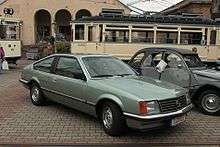
But the internals consisted of parts mainly borrowed from the Rekord E1 and later the E2, which meant cloth seats, and lots and lots of plastic on the dashboard and inner doors. Even the rev counter and the tachometer was taken directly from the Rekord E models, so that when you sat in one, the feeling was not that you drove a Monza, but more that you where driving a Rekord. If that wasn't enough trouble for Opel, they also experienced gearbox problems. The engine range for the Monza A1 was the 3.0S, the 2.8S, the newly developed 3.0E and later the 2.5E (the 3.0 had 180 bhp and 248 Nm with fuel injection), gave a wide range. The 3-speed Borg Warner automatic transmission from the Commodore range needed to be modified to cope with the new and improved power outputs. Opel's own 4-speed manual gearboxes were not up to the job and, instead of putting in a more modern 5-speed manual gearbox, Opel turned to gearbox and transmission producer Getrag, and installed the Getrag 264 4-speed manual gearbox in the early Monzas. But when people bought a big, luxurious coupé they wanted modern products as well, and Opel obliged, as soon the Getrag 240 (for the 2.5 engines) and the Getrag 265 (for the 3.0E), both 5-speed manual gearboxes, replaced the old 4-speed gearbox.
The Monza, however, sharing the same layout as the Senator A1, had very good driving abilities. It handled quite well, thanks to the newly developed MacPherson strut system for the front of the car, as used on the Rekord E1 and E2, and the new (previously Opel had always used a non-independent rear axle on the Rekord E1 and E2, Manta, Ascona etc.) independent rear suspension gave the car soft, yet firm and capable, driving characteristics and excellent stability for such a big car. The engine range, however non-economical, was also very good, and few problems with the extremely reliable engines, even today, some 30 years later. The 6-cylinder engines where all of the CIH type (camshaft in head) and were in reality a 2.0-litre straight 4 with just 2 more cylinders. Many parts on the engine, such as the water pump and drive train, are in fact the same parts as used on the 4-cylinder version. This meant that this was an engine not only tested for many years in the Commodore, Admiral and Diplomat range, but also very reliable. Although the first generation of 3.0E engines in the Monza A1 had overheating problems when standing still, this could easily be fixed by fitting an oil-cooler.
When Opel realized that the public disliked the Rekord interior, they introduced the "C" package. The "C" cars where fitted with extra instruments (oil pressure, voltmeter etc.) and the interior was either red, dark blue, green, or brown. As all parts of the interior were colored, it seemed more luxurious than it did previously.
The A1 also came with a sports package or "S" package. The cars all where marked as "S" models on the front wings, and came with 15-inch Ronal alloy wheels, a 45% limited slip differential.
However, being a coupe, it was rather large, and four well-sized adults had plenty of space. Even the boot was extremely large, and if that was not enough people had the possibility to flip down the rear seats to make even more space. The A1 was not a great hit at the customers even though it was fairly cheap to buy, the class of the car taken in consideration, and the fact that it actually got some good reviews by the press.
With the 3.0-litre engine, the Monza was at that time the fastest car Opel had ever built. Being capable of speeds as high as 215 km/h, and the 0–100 km/h mark went in just 8.5 seconds.
Monza A2 (1982–1986)
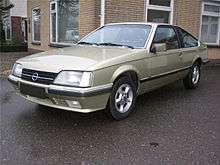
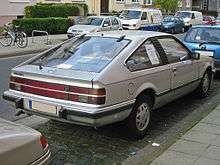
In 1982, the Monza, Rekord and Senator all got a face-lift and was named the A2 (E2 for the Rekord). The A2 looked similar to the A1 overall but with some meagre changes to the front end. The headlights noticeably increase in size, and the front looked more streamlined than that of the A1. Also the chrome parts like bumpers etc. was changed to a matt black finish, or with plastic parts. The bumpers was now made of plastic and made the Monza took on the look of a sports car in appearance, and actually did look like the Opel Manta car, despite the huge size difference. The rear lights were the same and the orange front indicators was now with white glass, giving a much more modern look to the car. Overall the update was regarded as successful although retrospectively some of the purity of the lines of the early car were lost.
At a time of rising fuel prices, the need for fuel efficiency was becoming paramount, and Opel decided to change the engine specifications of the Monza. This meant introducing both the straight 4 cylinder CIH 2.0E and the 2.2E engines from the Rekord E2. However, as the Monza weighs almost 1400 kg, and the 115 bhp of the two engines, the cars were underpowered and thus unpopular. The 2.5E was given a new Bosch injection system so between 136 and 140 bhp was available. The 2.8S was taken out of production. The 3.0E engine stayed the top of the range. The 3.0E was given an upgraded Bosch fuel injection and gained a small distance on a litre of fuel.
The cars now came with more luxurious interior, electrically controlled side mirrors and even an on-board computer, recording fuel consumption, speed and range.
Holden Monza
In Australia, local racing legend Peter Brock had plans to import, modify and market the Opel Monza Coupé as the Holden Monza with the Holden 5 Litre V8 fitted, through his own HDT (Holden Dealer Team) business, but the plans eventually fell through.[2] This was due to the expense of adapting the car to Australian Design Rules.[3] One model was built featuring a similar front end to the Holden Commodore VK along with other modifications including a 5.0 litre Holden V8 engine.[4]
Monza GSE
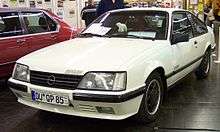
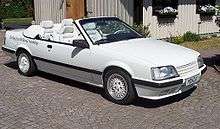
Keinath C5
The last incarnation of the Monza was the GSE edition in 1983; basically the A2 car, but a high-specification model which had Recaro sports seats, digital LCD instruments, and an enhanced all-black interior. It also featured a large rear spoiler on the boot. Also GS/E models are equipped with a 40% limited slip differential, an addition that had to be ordered separately on earlier 3,0E cars when purchasing.
By the time the Senator was updated to the new Senator B, and the Monza cancelled,43,812 Monzas had been built. There was no direct Monza replacement, although the idea of a large Opel/Vauxhall sporting car was also seen in the Lotus Carlton/Lotus Omega saloon. Bitter Cars put a 4.0 engine under the hood as a prototype. Three were built; two left hand drive and one right hand drive, one left hand drive burned out on a motorway in Germany and the other is in a museum, but the right hand drive one is in Somerset, UK.
Other uses of the Monza name
In South Africa, a saloon version of the smaller Opel Kadett E was also sold as the Opel Monza.[5] In Brazil and Venezuela, a version of the Opel Ascona C was sold as the Chevrolet Monza, which featured a three-door fastback body unique to Latin America.[6] There was also an unrelated Chevrolet Monza in the United States.
2013 Monza Concept
| 2013 Monza Concept | |
|---|---|
.jpg) | |
| Overview | |
| Manufacturer | Opel (General Motors) |
| Also called | Vauxhall Monza (United Kingdom) |
| Production | 2013 (Concept car) |
| Designer | Mark Adams |
| Body and chassis | |
| Class | Executive car (E) |
| Body style | 3-door 2+2 fastback coupé |
| Doors | Gullwing doors |
| Related | Opel Flextreme GT/E |
The Opel Monza Concept is a 3-door 2+2 fastback coupé plug-in hybrid concept car with 2 gullwing doors for easy access to the rear seats unveiled at the Frankfurt Motor Show in September 2013. The concept was also shown under the British Vauxhall marque.[7]
The concept shares the same basic plug-in hybrid setup as the Chevrolet Volt and Opel Ampera called "VOLTEC",[8] but using a turbocharged 1-liter 3-cylinder natural gas-powered engine as its range extender instead of General Motors’ current 1.4-liter gasoline Voltec engine.[9] The Monza Concept is the first car to feature cutting-edge LED projection infotainment.[10]
Dr. Karl-Thomas Neumann, the CEO of Opel has been quoted as saying "The Monza Concept is nothing less than our vision of the automotive future". According to Opel, this concept is the role-model for the next generation of Opel cars, and because of its modular chassis design, future cars based on it would be able to accommodate gasoline, diesel or electric power.[9][11]
Chief designer Ed Welburn of General Motors said "The gullwing doors will go into production and concept".[12]
References
- ↑ Vauxhall Royale and Royale Coupe (1978 - 1984), Honest John, 22 August 2013
- ↑ Monaro or Monza? Holden faces a coupe conundrum Wheels, June 8, 2015
- ↑ Opel Monza 2008 | Driving Brock's One-off Coupe, Performance, Drive.com.au
- ↑ GM HOLDEN monaro after 1978 COMMODORE PETER BROCK HDT
- ↑ Opel Monza commercial, 1986
- ↑ Brazil's J-Car, the Chevy Monza, bows in May, Automotive News, Crain Automotive Group, 1982, page 108
- ↑ Vauxhall Monza concept review, Daily Telegraph, Andrew English, 2 January 2014
- ↑ Matthe, Roland; Eberle, Ulrich (2014-01-01). "The Voltec System - Energy Storage and Electric Propulsion". Retrieved 2014-05-04.
- 1 2 Stephen Williams (2013-09-10). "Frankfurt Motor Show: The Opel Monza Returns". The New York Times. Retrieved 2013-09-11.
- ↑ "Monza concept to break cover at Frankfurt". Fit4Talent.com. Fit4Talent. 22 August 2013. Retrieved 22 August 2013.
- ↑ Jeffrey N. Ross (2013-09-10). "Opel Monza Concept soars into Frankfurt [w/video]". Autoblog.com. Retrieved 2013-09-11.
- ↑ Opel Monza concept at the 2013 Frankfurt auto show (IAA). Drivingthenation (September 2013)
External links
| Wikimedia Commons has media related to Opel Monza. |
| « previous — Opel car timeline, 1980s–present | |||||||||||||||||||||||||||||||||||||
|---|---|---|---|---|---|---|---|---|---|---|---|---|---|---|---|---|---|---|---|---|---|---|---|---|---|---|---|---|---|---|---|---|---|---|---|---|---|
| Type | 1980s | 1990s | 2000s | 2010s | |||||||||||||||||||||||||||||||||
| 0 | 1 | 2 | 3 | 4 | 5 | 6 | 7 | 8 | 9 | 0 | 1 | 2 | 3 | 4 | 5 | 6 | 7 | 8 | 9 | 0 | 1 | 2 | 3 | 4 | 5 | 6 | 7 | 8 | 9 | 0 | 1 | 2 | 3 | 4 | 5 | 6 | |
| City car | Agila A | Agila B | Karl | ||||||||||||||||||||||||||||||||||
| Adam | |||||||||||||||||||||||||||||||||||||
| Supermini | Corsa A | Corsa B | Corsa C | Corsa D | Corsa E | ||||||||||||||||||||||||||||||||
| Chevette | |||||||||||||||||||||||||||||||||||||
| Small family car | Kadett D | Kadett E | Astra F | Astra G | Astra H | Astra J | Astra K | ||||||||||||||||||||||||||||||
| Ampera | |||||||||||||||||||||||||||||||||||||
| Large family car | Ascona B | Ascona C | Vectra A | Vectra B | Vectra C / Signum | Insignia | |||||||||||||||||||||||||||||||
| Executive car | Rekord E / Commodore C | Omega A | Omega B | ||||||||||||||||||||||||||||||||||
| Full-size car | Senator A | Senator B | |||||||||||||||||||||||||||||||||||
| Coupé | Tigra A | ||||||||||||||||||||||||||||||||||||
| Manta B | Calibra | ||||||||||||||||||||||||||||||||||||
| Monza | |||||||||||||||||||||||||||||||||||||
| Convertible | Tigra TwinTop B | Cascada | |||||||||||||||||||||||||||||||||||
| Sports car | Speedster | GT (Roadster) | |||||||||||||||||||||||||||||||||||
| Mini MPV | Meriva A | ||||||||||||||||||||||||||||||||||||
| Compact MPV | Meriva B | ||||||||||||||||||||||||||||||||||||
| Zafira A | Zafira B | ||||||||||||||||||||||||||||||||||||
| Large MPV | Sintra | Zafira Tourer C | |||||||||||||||||||||||||||||||||||
| Mini SUV | Mokka | ||||||||||||||||||||||||||||||||||||
| Compact SUV | Frontera A | Frontera B | Antara | ||||||||||||||||||||||||||||||||||
| Mid-size SUV | Monterey | ||||||||||||||||||||||||||||||||||||
| Pick-up | Campo | ||||||||||||||||||||||||||||||||||||
| LAV | Kadett Combo | Combo B | Combo C | Combo D | |||||||||||||||||||||||||||||||||
| Van | Bedford Blitz | Arena | Vivaro A | Vivaro B | |||||||||||||||||||||||||||||||||
| Movano A | Movano B | ||||||||||||||||||||||||||||||||||||
